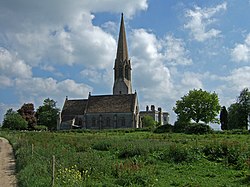Kingweston
| Kingweston | |
|---|---|
 The Approach to Kingweston Church |
|
 Kingweston |
|
| Kingweston shown within Somerset | |
| Population | 128 (2011) |
| OS grid reference | ST526311 |
| District | |
| Shire county | |
| Region | |
| Country | England |
| Sovereign state | United Kingdom |
| Post town | Somerton |
| Postcode district | TA11 6 |
| Dialling code | 01458 |
| Police | Avon and Somerset |
| Fire | Devon and Somerset |
| Ambulance | South Western |
| EU Parliament | South West England |
| UK Parliament | |
Kingweston is a village and civil parish in Somerset, England, situated 3 miles (4.8 km) north east of Somerton in the South Somerset district. The village has a population of 128.
The village's name was Chinwardestune in the Domesday Book of 1086. There is evidence of Romano-British occupation in Copley Wood.
After the Norman Conquest the manor was given to Eustance, Count of Bologne and held by his family until a descendant gave it to Bermondsey Abbey in 1114, who held the manor until the Dissolution of the monasteries. It then passed to the Smyth family of Long Ashton until it was bought in 1740 by Caleb Dickinson.
The parish was part of the hundred of Catsash.
The parish council has responsibility for local issues, including setting an annual precept (local rate) to cover the council’s operating costs and producing annual accounts for public scrutiny. The parish council evaluates local planning applications and works with the local police, district council officers, and neighbourhood watch groups on matters of crime, security, and traffic. The parish council's role also includes initiating projects for the maintenance and repair of parish facilities, as well as consulting with the district council on the maintenance, repair, and improvement of highways, drainage, footpaths, public transport, and street cleaning. Conservation matters (including trees and listed buildings) and environmental issues are also the responsibility of the council.
The village falls within the Non-metropolitan district of South Somerset, which was formed on 1 April 1974 under the Local Government Act 1972, having previously been part of Langport Rural District. The district council is responsible for local planning and building control, local roads, council housing, environmental health, markets and fairs, refuse collection and recycling, cemeteries and crematoria, leisure services, parks, and tourism.
...
Wikipedia

